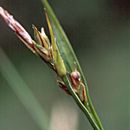Description
provided by eFloras
Plants densely to loosely cespitose; rhizomes arching, dark reddish brown, 0–5 mm, slender. Culms 6–34 cm, scabrous distally; bases weakly or not fibrous. Leaf blades pale green or glaucous, equaling or usually exceeding stems, 1.8–3.8 mm wide, coriaceous, glabrous abaxially, glabrous or scabrous adaxially. Inflorescences with both staminate and pistillate spikes; peduncles of basal spikes erect, short, stout; peduncles of terminal staminate spikes 2–2.5 mm; proximal nonbasal bracts leaflike, equaling or slightly exceeding inflorescences. Spikes: proximal pistillate spikes 2–6 (basal spikes 1–4); cauline spikes overlapping, with 1–4 perigynia; terminal staminate spikes 5.8–12.7 × 1.5–2.2 mm. Scales: pistillate scales reddish brown, with similarly colored or narrow white margins, ovate, 3.6–6 × 1.2–2.2 mm, apex cuspidate to acuminate (awned on some basal spikes); staminate scales lanceolate, 3.7–5.9 × 1.4–2.2 mm, apex acute to acuminate. Anthers 2.3–3.3 mm. Perigynia green, often with reddish brown tinge, 12–15 veined, conspicuous to at least mid body, ellipsoid, 4–5.3 × 1.4–2.2 mm; beak often bent, occasionally straight, pale green, 0.8–1.9 mm, ciliate-serrulate, apical teeth 0.2–0.5 mm. Stigmas 3. Achenes brown, ellipsoid, obtusely trigonous in cross section, 2.1–2.6 × 1.3–2.1 mm.
- license
- cc-by-nc-sa-3.0
- copyright
- Missouri Botanical Garden, 4344 Shaw Boulevard, St. Louis, MO, 63110 USA
Flowering/Fruiting
provided by eFloras
Fruiting late May–late Jul.
- license
- cc-by-nc-sa-3.0
- copyright
- Missouri Botanical Garden, 4344 Shaw Boulevard, St. Louis, MO, 63110 USA
Habitat
provided by eFloras
Dry, rocky, open coniferous woodlands on mountains; 600–2800m.
- license
- cc-by-nc-sa-3.0
- copyright
- Missouri Botanical Garden, 4344 Shaw Boulevard, St. Louis, MO, 63110 USA
Comprehensive Description
provided by North American Flora
Carex brainerdii Mackenzie, Bull. Torrey Club 40: 534. 1913
In large clumps, from interivoven, branched, woody, slender, more or less elongate rootstocks, the culms from verjshort to 30 cm. high, phyllopodic, reddened and slightly fibrtllose at base, much exceeded by the leaves, erect, ver>' slender, sharply triangular, very rough; sterile shoots aphyllopodic; leaves with well-developed blades 4-S to a fertile culm, the blades firm, light-green, keeled below, channeled above or nearly flat towards apex, the margins slightly revolute, those of the fertile culms short, of the sterile up to 40 cm. long, 1.5-3 mm. wide, long-attenuate, much roughened on both sides and averaging wider than those of the fertile culms; the sheaths whitish ventrally, breaking, very sparingly filamentose, slightly hispidulous dorsally, the ligule much wider than long; terminal spike staminate, slender, 5-12 mm. long, 0.5-2 mm. wide, sessile or short-peduncled or strongly peduncled, loosely 5-15flowered, the scales lanceolate or ovate-lanceolate, acuminate or cuspidate, chestnut-brown, becoming reddish-brown in age, with 1-3-nerved green center and broad hyaline margins; pistillate spikes 4-6, closely 1-6-flowered, the upper 2 or 3 and the staminate one approximate, sessile or short-peduncled, erect, the others nearly basal, widely separated and strongly peduncled (the erect peduncles not very elongate), the zigzag rachis often terminating in a sterile flower, the perigv'nia ascending in few rows; bracts of upper spikes well-developed, green, hyaline-margined and chestnut-tinged at base, all or only the lowest exceeding culm, the lower more or less strongly sheathing, the upper sheathless or nearly so; scales ovate or ovatelanceolate, cuspidate or long-awned, reddish-brown with I-3-nerved green center and wide, strongly white-hyaline margins, usually slightly longer but narrower than the perigynia; perigynia 4.5 mm. long, softly short-pubescent, membranaceous, light-green, in age becoming straw-colored, usually reddish-brown-tinged, the body oval, 2.5 mm. long, 1.75 mm. wide, strongly 2-keeled, finely many-ribbed on outer face, nearly orbicular in cross-section, strongly stipitate, the stipe 1 mm. long, abruptly contracted into a beak 1 mm. long, serrulate, hyalinetipped, bidentate; achenes triangular with strongly convex sides and prominent angles, very closely enveloped, 2.25 mm. long, nearly 1.75 ram. wide, short-stipitate, round-tapering at base, truncate at apex and slightly apiculate, jointed with the slender style; stigmas three, slender, long.
Type locality: El Dorado County, California (tirainerd 121).
DiSTRiBUTio.N': In the Sierra Nevada of California, from El Dorado County north to Siskiyou County, and in southern Oregon. (Specimens examined from southern Oregon. California.)
- bibliographic citation
- Kenneth Kent Mackenzie. 1935. (POALES); CYPERACEAE; CARICEAE. North American flora. vol 18(4). New York Botanical Garden, New York, NY
Carex brainerdii: Brief Summary
provided by wikipedia EN
Carex brainerdii, or Brainerd's sedge, is a species of sedge that was first described by Kenneth Mackenzie in 1913. It is native to California and Oregon.
- license
- cc-by-sa-3.0
- copyright
- Wikipedia authors and editors

